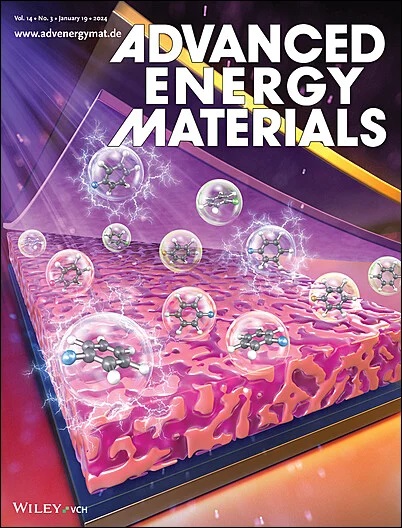IF 24.4
1区 材料科学
Q1 CHEMISTRY, PHYSICAL
引用次数: 0
摘要
水性锌离子电池(AZIBs)的广泛应用受到了极大的限制,原因是由于界面上 Zn2+ 的过快耗尽,形成了大量枝晶和有害的副反应,从而降低了循环稳定性并缩短了使用寿命。本文介绍了一种通过原位转换(NCF-Zn)产生的带负电的钕基薄膜,它能吸引 Zn2+ 离子,排斥 OH- 和 SO42- 阴离子。因此,较高的 Zn2+ 浓度可延缓 Zn2+ 因过快动力学而产生的贫化,降低成核障碍,从而均匀电沉积。同时,由于 OH- 和 SO42- 阴离子的排斥作用,可抑制 Zn 阳极上的副反应。利用这些协同优势,NCF-锌阳极可在电流密度为 10 mA cm-2 的锌|锌对称电池中实现超过 2500 小时的超稳定循环,并在电流密度为 5 mA cm-2 的锌|铜不对称电池中实现令人印象深刻的可逆性,库仑效率达到 99.93%。值得注意的是,组装好的 MnO2|NCF-Zn 全电池表现出显著的长期循环稳定性,在 1 A g-1 循环 1000 次后,其容量仍能保持 97.2%。这项研究为构建稳定的保护层提供了一种简单而有效的策略,推动了高可逆 AZIB 的发展。本文章由计算机程序翻译,如有差异,请以英文原文为准。

Postpone Interfacial Impoverishment of Zn-Ions via Neodymium-Based Conversion Films for Stable Zn Metal Anodes
The widespread adoption of aqueous zinc-ion batteries (AZIBs) is significantly limited by the diminished cycling stability and reduced lifetime caused by the formation of rampant dendrites and detrimental side reactions, resulting from over-fast depletion of Zn2+ at the interface. In this contribution, a negatively charged neodymium-based film via in situ conversion (NCF-Zn) is presented that attracts Zn2+ ions and repels OH− and SO42− anions. Thereby, a higher Zn2+ concentration is mentioned to postpone the impoverishment of Zn2+ due to the over-fast kinetics, lower the nucleation barrier, and thus uniform the electrodeposition. Meanwhile, the side reactions on the Zn anode can be suppressed due to the repelling of OH− and SO42− anions. Taking these synergetic advantages, the NCF-Zn anode enables ultra-stable cycles for more than 2500 h in Zn|Zn symmetric cells at a current density of 10 mA cm−2 and impressive reversibility of 99.93% Coulombic efficiency in Zn|Cu asymmetric cells at a current density of 5 mA cm−2. Notably, the assembled MnO2|NCF-Zn full cell demonstrates remarkable long-term cycling stability, retaining 97.2% of its capacity at 1 A g−1 after 1000 cycles. This work offers a straightforward yet effective strategy for constructing a stable protective layer, advancing the development of highly reversible AZIBs.
求助全文
通过发布文献求助,成功后即可免费获取论文全文。
去求助
来源期刊

Advanced Energy Materials
CHEMISTRY, PHYSICAL-ENERGY & FUELS
CiteScore
41.90
自引率
4.00%
发文量
889
审稿时长
1.4 months
期刊介绍:
Established in 2011, Advanced Energy Materials is an international, interdisciplinary, English-language journal that focuses on materials used in energy harvesting, conversion, and storage. It is regarded as a top-quality journal alongside Advanced Materials, Advanced Functional Materials, and Small.
With a 2022 Impact Factor of 27.8, Advanced Energy Materials is considered a prime source for the best energy-related research. The journal covers a wide range of topics in energy-related research, including organic and inorganic photovoltaics, batteries and supercapacitors, fuel cells, hydrogen generation and storage, thermoelectrics, water splitting and photocatalysis, solar fuels and thermosolar power, magnetocalorics, and piezoelectronics.
The readership of Advanced Energy Materials includes materials scientists, chemists, physicists, and engineers in both academia and industry. The journal is indexed in various databases and collections, such as Advanced Technologies & Aerospace Database, FIZ Karlsruhe, INSPEC (IET), Science Citation Index Expanded, Technology Collection, and Web of Science, among others.
 求助内容:
求助内容: 应助结果提醒方式:
应助结果提醒方式:


